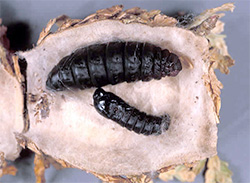ManageSafe
Least-Toxic Control of Bagworms Choose a different pests

|
Factsheet: Least-toxic Control of Bagworms
Identification
Pest type: Insects
In-depth Information:
Bagworms are the larval stage of moths. They attach their bags to and feed on ornamental plants such as evergreens, causing defoliation. Bagworms look like green or brown bags about 1/2 to 3 inches long and hang from branches like ornaments.
The most common species in the East usually attaches to junipers, pine hemlock, cedar, black locust, maple, sycamore, elm, buckeye, box elder and willow trees. In the Southern California region, bagworms are found mainly on ash, pear, sycamore, willow and locust trees. In Florida and other gulf coast states, look for bagworms on citrus and other subtropical plants. In temperate climates, the larvae hatch and begin feeding in late spring to early summer.
Is it a problem?
The bagworm has a voracious appetite and can cause serious damage to trees. Bagworms commonly feed on coniferous plants and on some deciduous trees and shrubs. Common evergreen hosts include juniper, arborvitae, spruce, and pine. The earliest signs of bagworm injury in evergreens are brown or stressed needles at the tips of branches. This is caused by the tiny, first-stage bagworm caterpillars etching needle surfaces as they feed. Heavy infestations of older bagworms may completely defoliate a tree or shrub. These plants can be severely stressed or even killed if control measures are not taken. Infestations can be caught in the fall after their cases have turned brown. By catching an infestation early enough, picking them off, or using least-toxic management strategies, you can save the tree.
Bagworms also feed on numerous deciduous trees, as well as many ornamental shrubs, but heavy infestations are relatively rare. Since deciduous plants can grow new leaves, damage is usually not serious.
Pest prevention practices
In-depth Information:
You can prevent or at least alleviate bagworm issues by planting flowers that attract bagworm-killing insects like parasitoid wasps and tachinid flies. A study published through University of Illinois at Urbana-Champaign found that planting asters and daisies near bagworm-infested trees and shrubs in urban landscapes promotes these beneficial insects, reducing bagworm populations. Flowering plants provide nectar and pollen for these natural enemy populations.
Birds, especially sparrows and finches, are also important predators of bagworms in late summer. By planting fruit and seed-bearing plants and providing shrubs for roosting, you can further prevent bagworm infestations.
Monitoring and record-keeping
Monitor all plants that have been infected with bagworms in the past. Begin searching for bags in the winter, as some will contain eggs that will hatch in the spring. Destroy any that you find. In May and early June, closely monitor all plants at least every other week.
Non-chemical and mechanical controls
Handpick and destroy
In-depth Information:
When there are only a few bagworms you can handpick and crush them. This must be done effective during fall, winter or early spring before the eggs hatch.
Biological controls
- If there are too many worms, consider using Bacillus thuringiensis, a soil dwelling, least-toxic bacterium. This can be found at most hardware and garden stores. Bt is most effective against young larvae. Make sure to apply to small bags. Apply Bt only to plants infected with bagworms since Bt is toxic to other species of caterpillars as well.
- Research has shown that nematodes (Steinernema carpocapse) also attack bagworms. When nematodes are sprayed onto the bags, they infect the female bagworms inside. Be sure to apply the nematodes before females lay eggs.
Least-toxic chemical options as a last resort
Neem oil and insecticidal soaps are quite effective against young bagworm larvae, but may require repeated applications.
Chemicals to Avoid
Look at your product labels and try to avoid products containing those chemicals listed below:
(A = acute health effects, C = chronic health effects, SW = surface water contaminant, GW = ground water contaminant, W = wildlife poison, B = bee poison, LT = long-range transport)
|
Acephate Bifenthrin Carbaryl Cyfluthrin | Cypermethrin Dimethoate Esfenvalerate Fluvalinate | Lambda-cyhalothrin Malathion Permethrin Pyrethrins | Spinosad Tebufenozide |
Social Media
See what other folks are saying about this, and let us know what works for you.
Click the post above to view and comment on Facebook, or comment directly on this site below.








